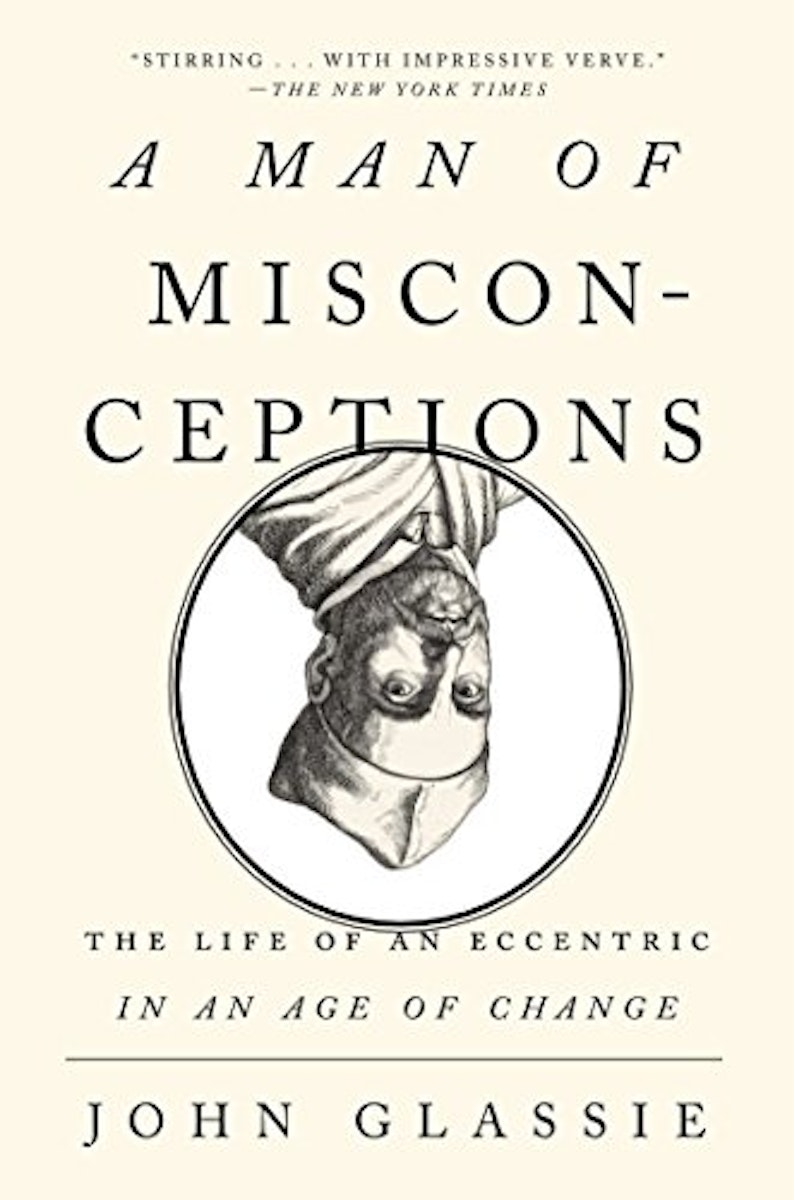
Athanasius, Underground
With his enormous range of scholarly pursuits the 17th-century polymath Athanasius Kircher has been hailed as the last Renaissance man and "the master of hundred arts". John Glassie looks at one of Kircher's great masterworks Mundus Subterraneus and how it was inspired by a subterranean adventure Kircher himself made into the bowl of Vesuvius.
November 1, 2012
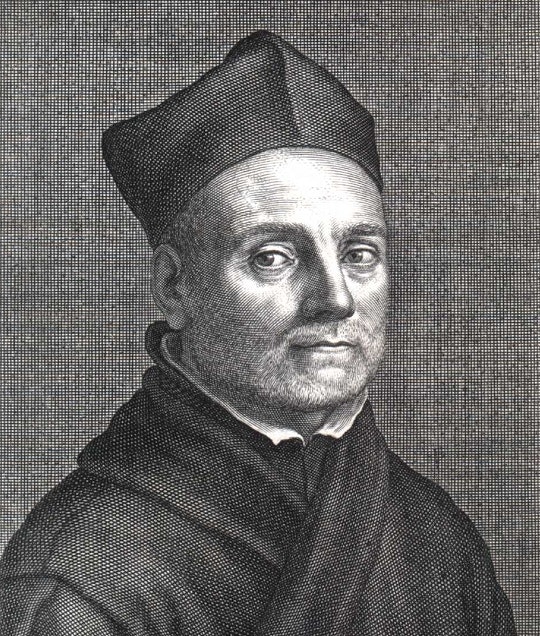 Scroll through the whole page to download all images before printing.
Scroll through the whole page to download all images before printing.Portrait of Kircher at age 53 from Mundus Subterraneus (1664).
Just before Robert Hooke’s rightly famous microscopic observations of everything from the “Edges of Rasors” to “Vine mites” appeared in Micrographia in 1665, the insatiably curious and incredibly prolific Jesuit scholar Athanasius Kircher published what is in many ways a more spectacular work. Mundus Subterraneus (Underground World), a two-volume tome of atlas-like dimensions, was intended to lay out “before the eyes of the curious reader all that is rare, exotic, and portentous contained in the fecund womb of Nature.” There is an “idea of the earthly sphere that exists in the divine mind,” Kircher proclaimed, and in this book, one of more than thirty on almost as many subjects that he published during his lifetime, he tried to prove that he had grasped it.
As a French writer put it some years later, “it would take a whole journal to indicate everything remarkable in this work.” There were extended treatments on the spontaneous generation of living animals from non-living matter, the unethical means by which alchemists pretended to change base metals into gold, and the apparent tricks of nature we now recognize as fossils. The book included detailed charts of “secret” oceanic motions, or currents, among the first ever published. The author’s more or less correct explanation of how igneous rock is formed was also arguably the first in print. According to one modern scholar, Kircher “understood erosion,” and his entries “on the quality and use of sand” and his “investigations into the tending of fields” had their practical use.
Mundus Subterraneus identified the location of the legendary lost island of Atlantis (something that modern science hasn’t been able to accomplish) as well as the source of the Nile: it started in the “Mountains of the Moon,” then ran northward through “Guix,” “Sorgola,” and “Alata” and on into “Bagamidi” before reaching Ethiopia and Egypt. Kircher offered a lengthy discussion of people who lived in caves (their societies and their economy). He reported on the remains of giants (also mainly cave dwellers) found in the ground. And he went into detail on the kinds of lower animals who belong to the lower world (including dragons).
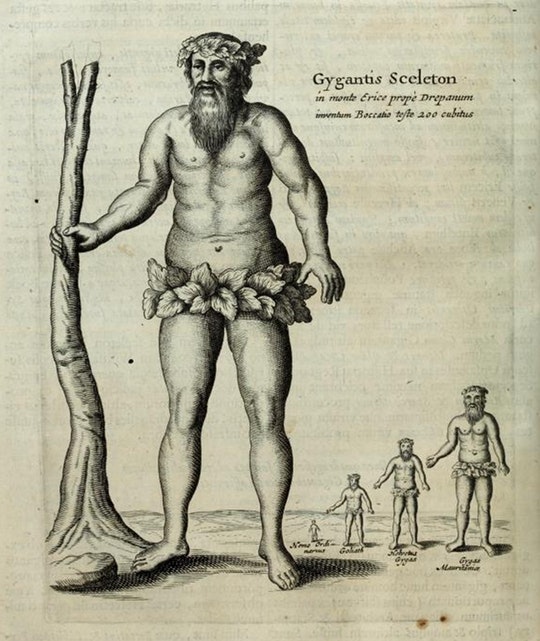 Scroll through the whole page to download all images before printing.
Scroll through the whole page to download all images before printing.Depiction of a Giant featured in Mundus Subterraneus.
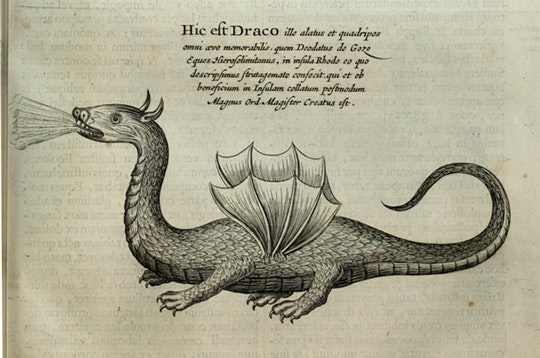 Scroll through the whole page to download all images before printing.
Scroll through the whole page to download all images before printing.Depiction of a Dragon featured in Mundus Subterraneus.
In short, Mundus Subterraneus covered almost every subject that might relate to the realm of earth, as well as many that wouldn’t seem to, such as the sun and “its special properties, by which it flows into the earthly world” and the “nature of the lunar body and its effects.” These correspondences and influences were nothing new, though perhaps only the always-inclusive Athanasius Kircher would choose to publish a series of moon maps in a book about the world below.
All these other subjects notwithstanding, it was Kircher’s theory about the interior of the earth that captured, or at least deserved, the most attention. As he explained, “the whole Earth is not solid but everywhere gaping, and hollowed with empty rooms and spaces, and hidden burrows.” Deep down, it holds many great oceans and fires, interconnected by a system of passageways that reached all the way to its core. In his view, volcanoes, however awful and awe-inspiring, “are nothing but the vent-holes, or breath-pipes of Nature,” and earthquakes are merely the “proper effects of subterrestrial cumbustions” that are sure to go on constantly. The “prodigious volcanoes and fire-vomiting mountains visible in the external surface of the earth do sufficiently demonstrate it to be full of invisible and underground fires,” he wrote. “For wherever there is a volcano, there also is a conservatory or storehouse of fire under it . . . . And these fires argue for deeper treasuries and storehouses of fire, in the very heart and inward bowels of the Earth.”
According to Kircher, “the fire and water sweetly conspire together in mutual service.” The tides, caused by the nitrous effluvia of the moon, push “an immense bulk of water” through “hidden and occult passages at the bottom of the Ocean” and thrust it “forcibly into the intimate bowels of the Earth.” The resulting winds “excite and stir up” and otherwise feed the subterraneous fire like a huge bellows. The seas, which would stagnate and freeze without the fires, keep the fires from getting out of hand, preventing “unlimited eruptions,” which would “soon turn all to ruins.” The “secret make-up of the mountains” is that they are hollow and serve as reservoirs. Hot baths, hot springs, and fountains are produced where underground water passageways come near or interconnect with the fire channels.
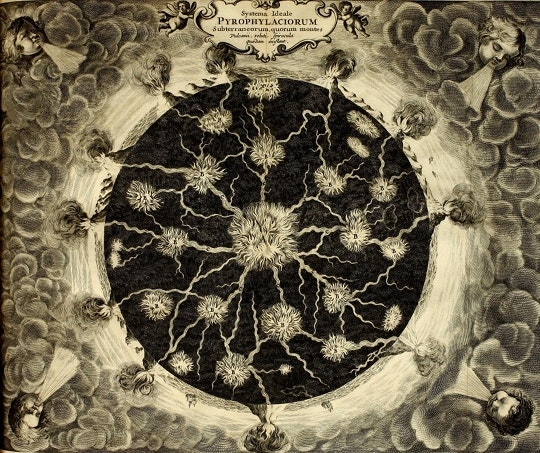 Scroll through the whole page to download all images before printing.
Scroll through the whole page to download all images before printing.Kircher’s diagram showing the interconnectedness of fire inside the earth, featured in Mundus Subterraneus.
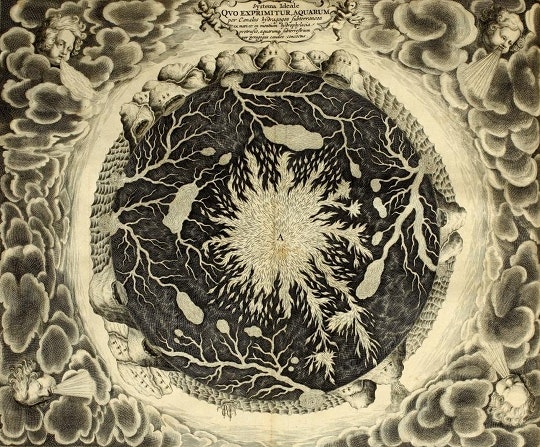 Scroll through the whole page to download all images before printing.
Scroll through the whole page to download all images before printing.Kircher’s diagram showing the interconnectedness of water inside the earth, featured in Mundus Subterraneus.
More than once, Kircher compares the movement of the earth’s water to the circulation of the blood in the body as described by William Harvey. The water of the oceans follows its “secret motions” up and around the globe toward the North Pole. Somewhere off the coast of Norway (the actual site of a major whirlpool system called the Moskenstraumen), he declared, is a giant maelstrom through which the water enters the earth — as if passing through a great drain — and runs through it, cooling it down, providing it with nutriments in particulate form before being eliminated through a nether opening at the South Pole. Sometimes the analogies referred more to the continuing process of the digestive system than the cycling of blood, but no matter: “You see therefore the manner and way of the Circulation of Nature.”
Kircher didn’t just (or didn’t entirely) make up his ideas about the interior of the earth. He’d first “learned the great secrets of Nature,” as he put it, almost thirty before, under circumstances of “great danger.”
Kircher was about thirty five years old, and had been based at the flagship Jesuit college in Rome for about three of four years — attempting to decipher the hieroglyphics of the ancient Egyptians — when in 1637 he was assigned to accompany a young German prince on an extended visit to Malta. If he was initially upset about being dragged away with an immature prince to some rocks in the middle of the Mediterranean, his curiosity quickly kicked in. He made magnetic and astronomical readings, and studied geological formations. There were four-hundred-foot cliffs, natural arches, and a place where the tides had carved human-looking shapes into the earth. He explored Malta’s megalithic temples, catacombs, and grottoes, and was especially fascinated by its inland seas and underground passageways: how far down did they go?
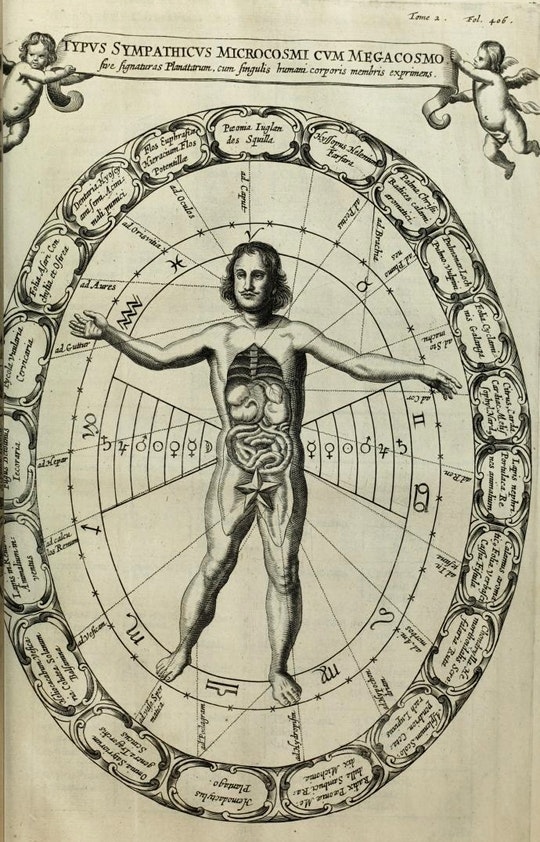 Scroll through the whole page to download all images before printing.
Scroll through the whole page to download all images before printing.Diagram showing the sympathies between the macro and microcosm, featured in Mundus Subterraneus.
After about a year, Kircher was finally allowed to return to Rome, but he took his time getting there and lingered in Sicily for a long while. “I found such a Theater of Nature, displaying herself in such a wonderful variety of things, as I had with so many desires wished for,” he wrote later. “Whatever thing occurs in the whole body of the Earth that is wonderful, rare, unusual, and worthy of admiration, I found contracted here.”
He was especially intent on exploring Sicily’s outcroppings, cliffs, and volcanoes. And he wanted to look into stories about a type of fish that lived in the Straits of Messina, the body of water that flows between Sicily and Calabria on the Italian mainland. The fish was supposed to be susceptible to a certain kind of song “by which,” Kircher wrote, “mariners are wont to allure it to follow their vessels.” But those plans had to be put aside because of the earthquakes that devastated much of Calabria in the spring of 1638.
Kircher recalled that the earthquake began as he and some others crossed the straits in a boat. The sea was “raging beyond what is usual” and began “stirring up huge whirlpools.” The island volcano of Stromboli was “throwing up huge billows of smoke,” and there was “a certain subterranean lowing, if you will, which we were reckoning to be the cracking of the earth and which seemed to conspire with the odor of sulfur to insinuate the complete, fatal and funereal destruction of Calabria and Sicily.”
Despite a “cracking racket” and a “noisome odor,” and the fact that the “sea itself was boiling,” Kircher and his party made it across to the mainland side. But soon enough came “a subterranean racket and din, similar to chariots driven at top speed.” The earth “leapt up from below with so forceful a motion that I, no longer able to stand on my feet, was laid low, suddenly dashed down with face flat on the ground.”
Kircher experienced “the intolerable frenzy of the earth,” and at one point even the feeling of his soul being “loosened from its corporeal fetters,” but survived to witness the resulting devastation. Through subsequent days of walking, his group “came upon nothing but cadavers of cities and the horrific ruins of castles,” he remembered. “Considering the men straggling through open fields as if extinguished for their fear, you would have said that at that very moment the day of final judgment was looming.”
Kircher’s firsthand experience of this earthquake, which killed something like ten thousand people, might have put him off his investigations into the “miracles of subterraneous nature.” But these horrible occurrences had also presented him with an opportunity for study. “After having diligently searched out the incredible power of Nature working in subterraneous burrows and passages,” he wrote, “I had a great desire to know whether Vesuvius also had not some secret commerce and correspondence with Stromboli and Aetna.”
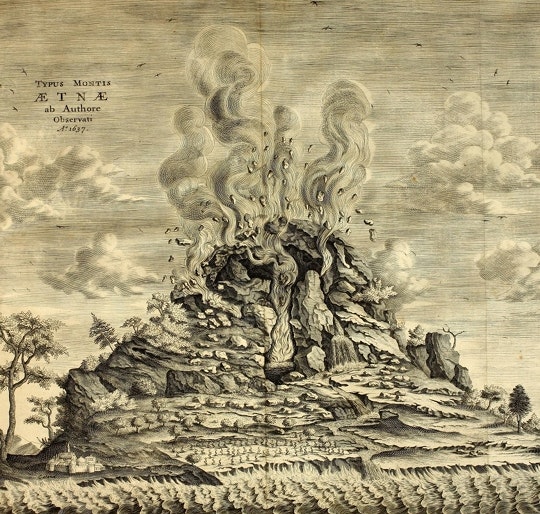 Scroll through the whole page to download all images before printing.
Scroll through the whole page to download all images before printing.Illustration of Mount Etna, featured in Mundus Subterraneus.
There was only one way, in his view, to find out. Vesuvius at that time was merely smoking. But its first major eruption in centuries had occurred seven years earlier, in 1631. Kircher hired “an honest country-man, for a true and skillful companion,” and the two began hiking their way up to the forty-two-hundred-foot summit at midnight. (Perhaps the reason for leaving at that hour was to be able to see in the dark anything that might be molten. Or maybe the idea was to allow for a full day of exploration once they got there.) The way was “difficult, rough, uneven, and steep.”
When they finally reached the top, Kircher looked down into the crater. “I thought I beheld the habitation of Hell,” he wrote, “wherein nothing seemed to be much wanting besides the horrid fantasms and apparitions of Devils.” He heard “horrible bellowings and roarings” and there was “an unexpressible stink.” The smoke and fire and stench “continually belch’d forth out of eleven several places, and made me in like manner belch, and as it were, vomit back again, at it.”
When the morning light came, Kircher recalled, “I chose a safe and secure place to set my feet sure upon, which was a huge Rock, of a plain surface, to which there lay open an avenue, by a descent of the mountain very far . . . . And so I went down unto it.”
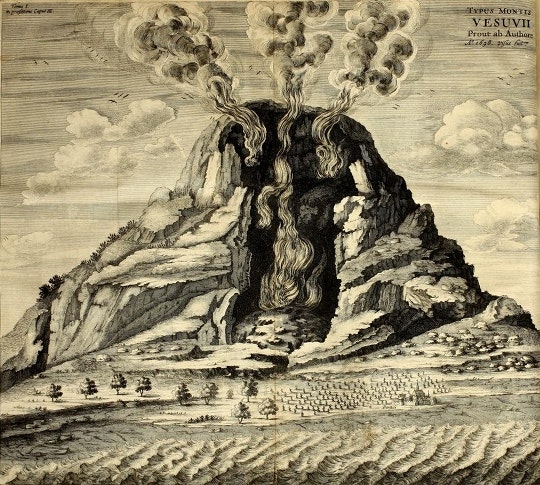 Scroll through the whole page to download all images before printing.
Scroll through the whole page to download all images before printing.Illustration of Mount Vesuvius into which Kircher climbed, featured in Mundus Subterraneus.
The inside of the volcano was, “all up and down everywhere, cragged and broken.” But there was no gradual decline; the volcano’s chamber was “made hollow directly and straight.” The bottom was “boiling with an everlasting gushing forth, and streamings of smoke and flames, and employed in decocting Sulphur, Bitumen and the melting and burning of other kinds of Minerals.”
Because the vapors and gases “know not how to be contained” within the molten matter, they did so “scatter the burden that lay upon them, with such great force and violence, accompanied with horrible cracklings and noises, that the mountain seemed to be tossed with an earthquake or trembling.” Those spewings caused “the softer parts of the Mountain,” made of, Kircher suggests, ashes, cinders, rains, and “the refuse of minerals,” to be shaken to pieces and loosened; they fell “like Hills, into the bottom of the Hellish gulph.” And that made the kind of sound that even “the stoutest and most undaunted heart would scarce venture to suffer.”
It was within this hollow mountain that Kircher really began to develop the theories he set down so many years later in Mundus Subterraneus, to envision what it might be like even deeper within the earth, and how the mountains and fires and rivers and oceans might somehow all be connected. Calculating the significance of that moment in the history of science is a lot harder than mentioning what appear to be two direct influences on culture: The creation of Bernini’s Fountain of the Four Rivers in Rome was certainly informed by Kircher’s ideas about the interior structure of the earth as well as his ideas about the mystical nature of the universe (that’s another story). And the spirited, bumbling polymath-dreamer of Jules Verne’s A Journey to the Center of the Earth, who leads a subterranean descent through an old volcanic crater, certainly seems to be based on Kircher himself.
John Glassie has written for The Believer, The New Republic, The New York Times Magazine, The Paris Review Daily, and The Washington Post, among other publications. This essay was adapted from his biography of Athanasius Kircher, A Man of Misconceptions: The Life of an Eccentric in an Age of Change, which was a New York Times Book Review "Editors' Choice".
Imagery from this post is featured in
Affinities
our special book of images created to celebrate 10 years of The Public Domain Review.
500+ images – 368 pages
Large format – Hardcover with inset image





